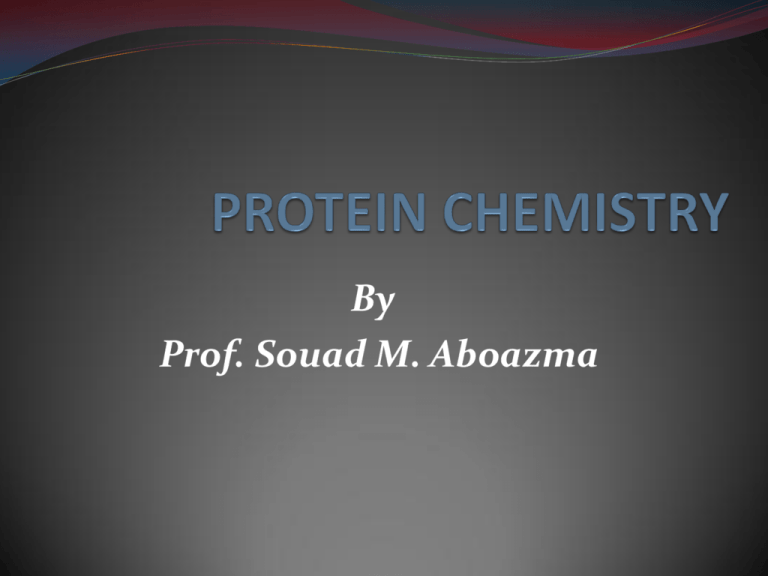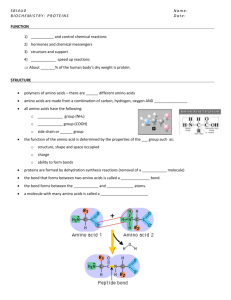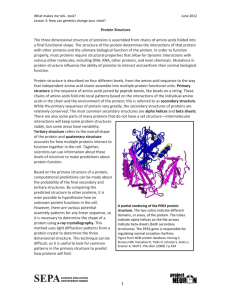PROTEIN CHEMISTRY
advertisement

By Prof. Souad M. Aboazma AMINO ACID CHEMISTRY Definition. Characters. Classification: Amino acids can be classified according to : Number of amino and carboxyl groups in the amino acid Nutritional : either essential or non essential amino acids Metabolic: either glucogenic or ketogenic amino acids Charge and polarity of side chain i) According to the number of amino and carboxyl groups in the amino acid Neutral amino acids Acidic amino acids Basic amino acids Neutral amino acids 1-Aliphatic amino acids: Glycine , Alanine, Valine , Leucine , Isoleucine. 2) Aromatic amino acids: Phenyl alanine, Tyrosine, Tryptophan. 3) Hydroxy amino acids: Serine, Threonine, Tyrosine. 4) Sulphur- containing amino acids: Methionine, Cystiene , Cyst in 5) Heterocyclic amino acids as histidine,tryptophan 6) Imino acids as proline &hydroxyproline, Acidic amino acids Aspartic acid and Glutamic acid . Basic amino acids Arginine and Lysine Heterocyclic amino acids Histidine ,Tryptophan, Proline and Hydroxyproline ii Nutritional Classification: 1) essential amino acids: Phenylalanine , Treptophan,Histidin . Methionine , Threonine . Leucine , Valine , Isoleucine. Arginine, Lysine . 2) non essential amino acids Glycine , alanine , serine , tyrosine , praline , hydroxyl praline , cystiene , cystin , aspartic acid & glutamic acid iii Metabolic Classification: 1- Glucogenic amino acids 2- Ketogenic amino acid as leucine 3- Both glucogenic and ketogenic amino acids as Tyrosine, phenylalanine, tryptophan, lysine & isoleucine iv According to charge and polarity of side chain 1- Hydrophobic, non polar uncharged amino acids as alanine,valine,leucine isoleucine &methionine 2- Hydrophilic polar: a- Uncharged polar amino acid as serine,threonine b- Charged polar amino acids Positively charged Negatively charged Properties of amino acids I. Physical properties: Soluble in water, strong acid and base. All are optically active due to presence of asymmetric carbon atom except glycine. They have all the biological importance of proteins. They are amphoteric due to presence of 2 groups [COOH (acidic) –NH2 (basic)], so they react with both acids and alkalies. * Iso-electric point [IEP] It is the pH at which the amino acid or proteins carry both +ve and –ve charge to form Zwitter ions. These ions are electrically neutral (do not move in electric field) and are easily precipitated. Each amino acid has its specific I.E.P. Zwittern ion: It is the dipolar ion of amphoteric compounds (amino acid and proteins) produced when the pH of the medium is at the I.E.P. It carries both +ve and –ve charges and thus it is electrically neutral (does not move in electric field). II. Chemical properties A- Reactions due to NH2 group: 1- Reaction with acids to form salt 2-Reaction with nitrous acid to liberate nitrogen . in all amino acids except proline and hydroxyproline. 3- Reaction with acetyl chloride ( acetylation reaction) Amino acid reacts with acetyl chloride to give acetyl amino acid. 4- Reaction with CO2 to form carbamino compounds 5- Reaction with methyl iodide ( methylation reactions) 6- Deamination of amino acids Oxidative deamination: Produces α – keto aid and NH3. Reductive deamination: Produces fatty acid and NH3. Hydrolytic deamination: Produces hydroxyl fatty acid and NH3 B- Reactions due to COOH group: Reaction with strong alkalies to form salt Reaction with alcohols to form esters Decarboxylation reaction: To form primary amines e.g Histidine Histamine. Tryptophan Tryptamine. Serine Ethanolamine. C- Reaction due to both NH2 and COOH group Amino acids condense with each other by COOH group at one amino acid with NH2 of other amino acid to form peptide bond. If 3 amino acids condense together they form tripeptide . D-Reactions due to radical R: According to the side chain amino acids give colour reaction as : - sulfur test for sulfur containing a.a. - Xanthoproteic test for aromatic a.a. - Rosenheim test for tryptophan (indol ring). - Millon’s test for phenol group as tyrosine. - Ninhydrin reaction :all amino acids give blue colour except proline which give yellow colour. PROTEIN CHEMISTRY Definition Proteins are organic complex nitrogenous compounds of high molecular weight, formed of C, H, O, N [N= 16%]. They are formed of a number of amino acids linked together by peptide linkage [-CO-NH-]. The carboxylic group of the first amino acid units with the amino group of the second amino acid and so on. Biological importance of proteins They provide the body with nitrogen, sulfur, and some vitamins. Formation of enzymes and protein hormones. Formation of supporting structures in the body as bone, cartilage, skin, nails, hair and muscles. They enter in the formation of buffer system of the blood. They enter in the formation of haemoglobin They include plasma proteins, which carry hormones, minerals and lipids (in the form of lipoprotein complex). They enter in formation of antibodies (immunoglobulins). General properties of proteins Proteins are substances of high molecular weight. Proteins form colloidal solution and having its same properties as: Tyndall effect & Brownian movement Proteins are non dialyzable due to their large molecules. Proteins are amphoteric which liable to react with acid and alkali. Each protein has its own isoelectric point. Protein acts as a buffer solution which resists the change of its pH by addition of acid or alkali. •Denaturation Denaturation of protein it is a change in native state (physical, chemical, and biological properties) of proteins without destruction of their peptide linkages ,but destruction of secondary bonds leading to unfolding protein molecule. Denaturating agents: Physical: High temperature, high pressure, X-ray, ultraviolet rays- mechanical agitation. Chemical: Strong acids, strong alkalies, organic solvents, heavy metals. Results of denaturation: Physical: Decrease solubility, Iincrease viscosity and can not be crystallized. Chemical: Unfolding of the protein molecule. Destruction of some subsidiary hydrogen bonds. Exposure of some groups as (SH) of cystiene. Biological: Loss of activity, if it is hormone or enzyme. Loss of antigen antibody reaction (allergicmanifestation). Easily digested . Folloculation of proteins It is a precipitation of denaturated protein at its I.E.P. This folloculation is dissolved again by changing pH from the I.E.P by addition of acid or alkali (reversible). Coagulation of prteins Boiling of the folloculated protein changing it to coagulum. This coagulum can not dissolved again even by changing the pH (irreversible). Precipitation of proteins Proteins are precipitated from solution by many ways: At I.E.P. By high concentrations of neutral salts as ammonium sulfate, Mg sulfate, Na chloride. By heavy metals e.g. silver nitrate, lead acetate. By strong acids e.g. trichloro acetic acid (TCA), phosphotungestic acid, picric acid. By organic solvents which are miscible with H2O e.g. ethyl alcohol, methyl alcohol, acetone…. Fractionation of proteins Precipitation by neutral salts Electrophoresis: It is the migration of proteins in an electric field. Proteins in alkaline medium migrate to anode. Proteins in acidic medium migrate to cathode. When a sample of plasma proteins is subjected to electrophoresis, albumin will be the fastest in migration followed by α – globulin, β – globulin, γ – globulin. This method is used to diagnose any abnormalities in plasma proteins. Ultracentrifugation: Centrifugation of proteins at very high speed according to molecular weight. Chromatography & dialysis. Classification of proteins Prpteins can be classified on the basis of their solubility, shape,biological functions,or chemical composition 1-Classification of proteins according to their solubility: Proteins soluble in H2O,or other biological solvents (Albumin –globulin- Histones – Protamin - prolamin – glutelins) Proteins not soluble in most protein solvents [albuminoids] as nail and hair. 2-According to their shape: A- Globular proteins : axial ratio is more than 10,more stable as keratin & myosin in muscles. B-Fibrous proteins : axial ratio is less than 10 , less stable as albumin & globulin. 3-according to their biologic functions : Enzymes: e.g. dehydrogenases, kinases Storage proteins: ferritin , myoglobin Regulatory proteins: DNA-binding protein, peptide hormones Structural proteins: collagen Protective proteins: clotting factors , immunoglobulins Transport proteins: hemoglobin , plasma lipoproteins Motile proteins: actin, tubulin 4-according to their chemical composition A-Simple proteins: On hydrolysis, they produce only amino acids as albumin ,globulins, glutellin Prolamines,protamines,histones, albuminoids(scleroproteins). albuminoids (scleroproteins) They are fibrous proteins. Insoluble in H2O, dilute acids and alkali, and all neutral solvents. Not digested by proteolytic enzymes. Found in animal tissues and having supportive and protective function as keratin ,elastin ,collagen & gelatin. B-Conjugated proteins (compound protein) These are formed of protein part and non protein part. According to non protein part, they are divided into: 1- Glycoproteins and Mucoproteins: Protein conjugated with carbohydrate e.g. certain hormones [FSH, LH, TSH] & Immunoglobulins IMMUNOGLOBALINS (IGs) Globulins are mainly formed in reticuloendothelial system in macrophages and lymphocytes. Immune system is divided into : B-cells (Bone marrow): concerned with circulating humeral antibodies. T-cells (Thymus glands): concerned with cell mediated immune response as graft rejection, hyypersensitivity reactions and defense against malignant cells and viral infection. Lipoproteins: Protein conjugated with lipids either [phospholipids- triglyceride- cholesterol] e.g. Chylomicrons – VLDL – LDL – HDL. It is the transport form of lipids in blood. Phosphoproteins: Protein conjugated with phosphoric acid thruogh hydroxylic group of serine, threonine &tyrosine Casienogen is an example for phosphoproteins (the main protein of milk ). Metalloproteins Proteins conjugated with metals e.g. Ceruloplasmin = protein + Cu. Insulin = protein + zinc. Chromoproteins: Hemoglobin containing Fe-porphyrin (red color). Chlorophyll containing Mg-porphyrin (green color). Flavoproteins: These are enzymes containing FMN, FAD (yellow color). Nucleoproteins: Proteins conjugated with nucleic acids e.g. Histone associated with DNA in chromosomes. C-Derived proteins These are the denaturated or hydrolytic products of either simple or conjugated proteins. 1- Primary protein derivatives: These results from alteration of proteins from its native state without hydrolysis: Metaproteins: Due to the effect of acid or alkali e.g.: Acid or alkali metaprotein. Gelatin [denaturated collagen]. Coagulated proteins: Due to the effect of heat e.g. Coagulated albumin and globulin. 2-Secondary protein derivatives: These are the hydrolytic priducts of proteins Proteoses: Result from partial hydrolysis of proteins. Peptones: Result from further hydrolysis of proteases. Soluble in H2O. •Peptides: Resulting from further hydrolysis of peptones. • Amino acids Structure of proteins: Proteins are formed of a large number of amino acid linked togther by peptide bonds (polypeptide chain). There are four orders of protein structures Primary structure of Proteins: Referred to the number, type and sequence of amino acids in the polypeptide chain. Any change in one of amino acids in polypeptide chain produces a physiological defect. The main bond in this structure (peptide bond) –CO-HN- Secondary Structure of Proteins The polypeptide chain will be folded to give a specific conformational form which may be : The α-Helix The α-helix is a common secondary structure encountered in proteins of the globular class. The formation of the α-helix is spontaneous and is stabilized by H-bonding between amide nitrogens and carbonyl carbons of peptide bonds spaced four residues apart. This orientation of H-bonding produces a helical coiling of the peptide backbone such that the R-groups lie on the exterior of the helix and perpendicular to its axis. β-pleated Sheets β-sheets are composed of 2 or more different regions of stretches of at least 5-10 amino acids. The folding of the polypeptide backbone aside one another to form βsheets is stabilized by H-bonding between amide nitrogens and carbonyl carbons. β-sheets are said to be pleated. This is due to positioning of the α-carbons of the peptide bond which alternates above and below the plane of the sheet. It formed by hydrogen bonds or disulfide bonds between two extended polypeptide chains or between two regions of single chain. β-pleated sheets exist in two forms: parallel (the adjacent chains are aligned in the same direction with respect to Nterminal and carboxy terminal residues) and antiparallel (the two chains are arranged in opposite direction ) . - Loop sheets: Half of the residues in a typical globular protein are present in α helices or β pleated sheets, the remainder reside in loop or coil conformation which form the antigen- binding sites of antibodies. These loops should not be confused with random coils which are biologically unimportant conformations of denatured proteins - supersecondary structures (motifs): α helices or β pleated sheets form recognizable supersecondary motifs,such as: β– α – β: ( two strands of β sheets connected by α helix β – hair pin-: two antiparallel β sheets connected by short regions of loop. helix-turn-helix (HTH) is a major structural motif capable of binding DNA. It is composed of two α helices joined by a short strand of amino acids Tertiary Structure of Proteins Tertiary structure refers to the complete threedimensional structure of the polypeptide units of a given protein. Secondary structures of proteins are coiled to constitute distinct structure called domain. Domains arefundamental functional three dimentional structural units of polypeptides. Therefore, tertiary structure also describes the relationship of different domains to one another within a protein molecle The core of a domain is built from combinations of secondary structural elements (motifes). The interactions of different domains is governed by several forces: These include hydrogen bonding, hydrophobic interactions, electrostatic interactions and van der Waals forces. Forces Controlling Tertiary Protein Structure 1-Hydrogen Bonding: Polypeptides contain numerous proton donors and acceptors both in their backbone and in the R-groups The environment in which proteins are found also contains H-bond donors and acceptors of the water molecule. H-bonding, therefore, occurs not only within and between polypeptide chains but with the surrounding aqueous mediumof the amino acids. 2- Hydrophobic Forces: Proteins are composed of amino acids that contain either hydrophilic or hydrophobic R-groups. It is the nature of the interaction of the different R-groups with the aqueous environment that plays the major role in shaping protein structure. The hydrophobicity of certain amino acid Rgroups tends to drive them away from the exterior of proteins and into the interior. This driving force restricts the available conformations into which a protein may fold. 3- Electrostatic Forces: Formed between oppositely charged groups in the side chains of amino acid. e.g. ε- amino group of lysine and carboxyl group of aspartate. Lysine – NH3+ …………….-OOC-aspartate 4- van der Waals Forces: There are both attractive and repulsive van der Waals forces that control protein folding. Attractive van der Waals forces involve the interactions among induced dipoles that arise from fluctuations in the charge densities that occur between adjacent uncharged nonbonded atoms. Repulsive van der Waals forces involve the interactions that occur when uncharged nonbonded atoms come very close together but do not induce dipoles. The repulsion is the result of the electron-electron repulsion that occurs as two clouds of electrons begin to overlap. 5- Disulphide bonds: Formed between 2 cystiene residue, it connect 2 polypeptide chain or 2 sections in one chain. It is covalent bond. Quaternary Structure of Proteins Many proteins contain 2 or more different polypeptide chains that are held in association by the same non-covalent forces that stabilize the tertiary structures of proteins. Proteins with multiple polypetide chains are oligomeric proteins. The structure formed by monomer-monomer interaction in an oligomeric protein is known as quaternary structure. Oligomeric proteins can be composed of multiple identical polypeptide chains or multiple distinct polypeptide chains. Proteins with identical subunits are termed homo-oligomers. Proteins containing several distinct polypeptide chains are termed hetero-oligomers. Hemoglobin, the oxygen carrying protein of the blood, contains two α and two β subunits arranged with a quaternary structure in the form, α2β2. Hemoglobin is, therefore, a hetero-oligomeric protein. Protein folding Protein folding is the process by which a string of amino acids (the chemical building blocks of protein) interacts with itself to form a stable three-dimensional structure during production of the protein within the cell. The folding of proteins thus facilitates the production of discrete functional entities, including enzymes and structural proteins, which allow the various processes associated with life to occur Importance of folding protein molecules Protein folding is essential for the production of structures that can perform particular functions in the cell . Also it prevents inappropriate interactions between proteins, in that folding hides elements of the amino acid sequence which if exposed would react non-specifically with other proteins. Protein misfolding Under favorable conditions, most proteins have no problem quickly folding to their native structures. However, there are some proteins which appear unable to fold without the presence of other helper proteins, called chaperones. In the absence of chaperones, these proteins will fail to achieve their native state and instead may associate with other unfolded polypeptide chains to form large aggregate structures. Inappropriate folding is one way in which a protein imbalance may arise – the misfolded protein may be nonfunctional or suboptimally functional, or it may be degraded by cellular machinery Protein misfolding diseases In many cases, misfolded proteins are recognised to be undesirable by a group of proteins called heat shock proteins, and consequently directed to protein degradation machinery in the cell. This involves conjugation to the protein ubiquitin, which acts as a tag that directs the proteins to proteasomes, where they are degraded into their constituent amino acids. Hence many protein misfolding diseases are characterised by absence of a key protein, as it has been recognised as dysfunctional and eliminated by the cell’s own machinery. Diseases caused as a consequence of misfolding, include cystic fibrosis & other disease . In addition, some cancers may be associated with misfolding. Many protein misfolding diseases are characterised not by disappearance of a protein but by its deposition in insoluble aggregates within the cell. Diseases caused by protein aggregation include Alzheimer’s disease (deposits of amyloid beta and tau), Type II diabetes (depositis of amylin), Parkinson’s disease (deposits of alpha synuclein),









